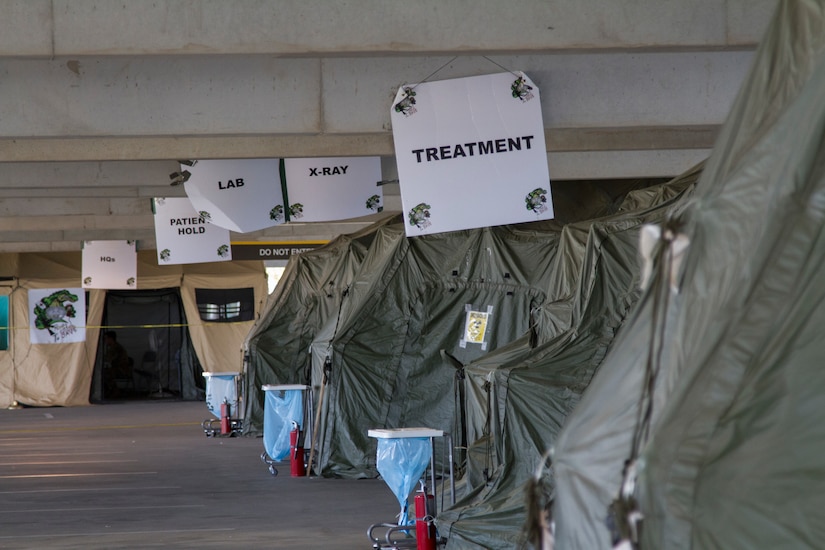Sept. 22, 2020 |
The 1st Medical Brigade, 13th Expeditionary Sustainment Command, has been crucial in supporting COVID-19 testing and mitigation efforts in Texas and across the United States since March. As they assist Carl R. Darnall Army Medical Center, Fort Hood, Texas, in the fight against COVID-19, they continue to solidify themselves as the premier medical brigade in the Army.
The 61st Multifunctional Medical Battalion, 1st Med. Bde. has led efforts at CRDAMC's COVID-19 testing drive-thru site inside the hospital's garage since June 29, 2020.
In an effort to reduce the health risks to personnel in CRDAMC, the screening site helps identify people with respiratory illness symptoms before they enter the hospital.

Before the cars move inside the garage, where the occupants' vitals are taken, the occupants see the medical professionals for Role 2 medical care and possible testing. It's important to ensure they are there for the right reasons.
"We screen them and make sure they actually need to be here to get tested first," Army Staff Sgt. Nelson Smith, healthcare noncommissioned officer in charge with 546th Med. Company Area Support, 61st MMB, said.
During the screenings, there are certain criteria that will immediately cause the medics to have the vehicles proceed into the garage.
"If they were exposed to someone who was known to have COVID-19, have been out of Texas within 14 days or are showing symptoms, we will move them in for testing," Smith said.
If no symptoms are present, personnel will not be tested at the site. Smith said there is also one other common instance that results in no test being administered.
"Some people may come in and say their spouse has tested positive and would like to also be tested," Smith explained. "At that point, we won't test them here, because if one person in the house tests positive, we assume the entire house is positive living in close quarters with each other."
Once someone is identified to be tested, their samples are taken to CRDAMC and the results come back typically within 72 hours.
If a patient is identified as needing Role 2 treatment, a system is in place to minimize the possible spread of COVID-19.
"A medic will radio the make, model and license plate of the vehicle so transport can pick them up from their vehicle and take them to Role 2," Smith said. "That's to avoid any possible contamination with rails, or if we have a really sick patient to avoid them having to walk themselves."
Army Capt. Joshua Gurr and Army 1st Sgt. Christopher Lane, both members of the 546th command team, oversaw operations at the site, and Gurr acknowledged the uniqueness of their current fight.
"As leaders, we try to predict the enemy's movements in order to react, to seize [the] moments and capitalize on opportunities," Gurr said. "The enemy for our mission is COVID, which is unpredictable."

The health of the force is always a priority and it's something that concerns Gurr as the commander.
"With how contagious it is, I'm concerned about my soldiers," Gurr said. "If they are treating a patient, they run the risk of catching COVID themselves. Even after we use all our safety measures and precautions, the risk still exists. So, it's something we constantly manage."
Lane praised his soldiers for their efforts supporting the fight against the pandemic.
"It's a proud moment for me," Lane said. "Fighting an unknown enemy like COVID, is something a lot of soldiers don't get recognized for as if they were fighting in Iraq or Afghanistan. They are doing something greater than themselves and also get to excel at their craft as medical professionals."
With no end date to drive-thru support set, the soldiers are motivated to continue their mission.
"Our teams are prepared to run the station for as long as it takes," Smith said.
(Army Sgt. 1st Class Kelvin Ringold is assigned to the 13th Expeditionary Sustainment Command).






No comments:
Post a Comment